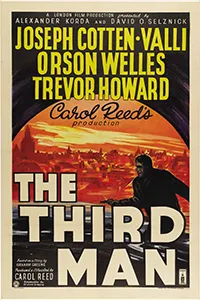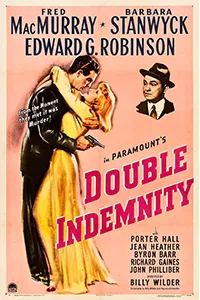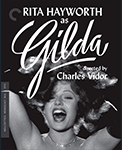GILDA
“Gilda” is an iconic and enduring film noir masterpiece from 1946, directed by Charles Vidor and starring Rita Hayworth, Glenn Ford, and George Macready. The film tells the story of Johnny Farrell (Ford), a small-time gambler who is hired by the powerful casino owner Ballin Mundson (Macready) to work at his club in Buenos Aires. However, when Mundson’s wife, Gilda (Hayworth), arrives on the scene, Johnny is forced to confront his past and deal with the dangerous power struggles that threaten to tear his world apart. With its dark and seductive atmosphere, intricate plot, and powerful performances, “Gilda” has become an enduring classic of the film noir genre, and a must-see for cinephiles and casual movie fans alike.
PLOT
“Gilda” is a fascinating film noir that tells a complex and multi-layered story of love, betrayal, and revenge. The film is set in Buenos Aires in the post-World War II era and centers around Johnny Farrell (Glenn Ford), a small-time gambler who becomes the right-hand man of the powerful casino owner Ballin Mundson (George Macready). Johnny quickly finds himself in over his head when he is caught up in a dangerous web of deceit and intrigue, where the lines between loyalty and betrayal are blurred.
The plot of “Gilda” is driven by the complicated relationships between the central characters. Johnny and Ballin have an unusual bond that is built on a foundation of power and control. Johnny uses his cunning and street smarts to help Ballin stay on top, while Ballin provides Johnny with a sense of purpose and security that he has never known before. However, when Ballin’s wife, Gilda (Rita Hayworth), arrives in Buenos Aires, everything changes.

Gilda is a mesmerizing femme fatale who immediately captures Johnny’s attention and sparks jealousy in Ballin. Johnny is initially hesitant to act on his attraction to Gilda, but as their relationship deepens, he discovers that she is hiding a dark secret from her past. This secret threatens to unravel everything that Johnny and Ballin have worked for, as it draws the attention of a group of Nazi war criminals who are hiding out in Buenos Aires.
The plot of “Gilda” is full of twists and turns that keep the audience guessing until the very end. One of the most memorable moments in the film is Gilda’s nightclub performance of the song “Put the Blame on Mame,” which has become an iconic moment in cinematic history. The scene is a testament to the power of Hayworth’s performance, as she uses her sensuality and charisma to captivate the audience and steal the show.

Another standout moment in the film is the final confrontation between Johnny and Gilda, which is a masterclass in tension and suspense. The scene is expertly shot and edited, with the lighting and framing perfectly capturing the emotional climax of the film.
The plot of “Gilda” is also notable for its exploration of complex themes such as power, control, and revenge. The characters’ motivations and allegiances constantly shift and evolve throughout the film, and the audience is left wondering who can be trusted and who is playing a long game of manipulation and deceit.
RECEPTION
 Upon its release in 1946, “Gilda” was a box office success, grossing over $4 million, and was widely viewed as one of the most controversial films of its time. The film was praised for its stylish visuals and intense performances, but also criticized for its uneven pacing and questionable morality.
Upon its release in 1946, “Gilda” was a box office success, grossing over $4 million, and was widely viewed as one of the most controversial films of its time. The film was praised for its stylish visuals and intense performances, but also criticized for its uneven pacing and questionable morality.
Despite these criticisms, “Gilda” received several award nominations, including a Best Cinematography nomination at the Academy Awards. The film’s iconic score, which included the famous song “Put the Blame on Mame,” was also widely praised and became a hit in its own right. The song was recorded by several artists, including Peggy Lee and Allan Roberts, and was covered by musicians and performers over the years.
The film’s provocative themes, including sexual desire and jealousy, were also groundbreaking for their time, and paved the way for future films to explore similar topics. The film’s impact on the film noir genre and its place in the history of Hollywood cinema cannot be overstated, and it continues to be studied and analyzed by film scholars and enthusiasts to this day.
THEMES
At its core, “Gilda” is a film that explores the complex interplay between power, control, and desire. The characters in the film are all driven by these motivations, and the narrative is shaped by the ways in which they interact with each other.
One of the central themes of the film is the question of who holds the power in any given relationship. Throughout the film, Johnny, Ballin, and Gilda all struggle to assert their dominance over each other, with each character vying for control in their own way. This struggle for power is seen most clearly in the relationship between Johnny and Gilda, as they engage in a dangerous game of seduction and manipulation.

Another important theme in the film is the idea of redemption and transformation. Johnny is a character who undergoes a significant transformation over the course of the film, as he grapples with his feelings for Gilda and the sense of loyalty he feels towards Ballin. Through his experiences, Johnny comes to realize that he is capable of being more than just a small-time gambler, and he ultimately seeks redemption for his past mistakes.
The theme of transformation is also evident in the character of Gilda, who is revealed to be much more complex than she initially appears. Although she presents herself as a femme fatale who is only interested in manipulating the men around her, it becomes clear that Gilda is also a victim of circumstance, trapped in a life that she did not choose for herself. Her desire for control and independence ultimately leads her down a dangerous path, and it is only through her own transformation that she is able to find a sense of peace.
Another key theme in “Gilda” is the legacy of the Second World War and the rise of fascism. The film takes place in Buenos Aires, a city that was a hub of activity for Nazi war criminals who fled to South America after the war. This historical context is reflected in the narrative of the film, as the characters are forced to confront the reality of what happened during the war and the ways in which it continues to shape their lives.
Finally, “Gilda” is a film that grapples with the complexities of human relationships and the ways in which people can both love and hurt each other. The characters in the film are all flawed and imperfect, and their relationships are marked by a sense of betrayal and mistrust. However, despite the many obstacles they face, the characters in “Gilda” ultimately find a sense of hope and redemption, suggesting that even in the darkest of circumstances, there is always the possibility for transformation and renewal.
Overall, the themes in “Gilda” are complex and multifaceted, reflecting the intricate interplay between power, control, desire, and human relationships. Through its masterful storytelling and captivating performances, the film explores these themes in a way that is both thought-provoking and emotionally resonant, making it a timeless classic of the film noir genre.
PUT THE BLAME ON MAME
The song “Put the Blame on Mame” from the film “Gilda” is an iconic piece of music that has had a lasting impact on popular culture. The song was written by Allan Roberts and Doris Fisher, and was famously performed by the film’s star, Rita Hayworth, in a memorable scene that has become one of the most iconic moments in the history of cinema.
In the scene, Hayworth, as the character Gilda, performs the song while sensuously removing one of her gloves. The performance and the song itself became synonymous with Hayworth’s image and persona, and helped to cement her status as one of the most alluring and captivating stars of the era.
Interestingly it was revealed in the commentary following the airing of “Gilda” on TCM, that Anita Ellis provided the vocals for the big production version of “Put the Blame on Mame,”, but it was Rita Hayworth herself who sang the song in the scene where she strums the guitar at the bar. This revelation adds another layer of talent and skill to Hayworth’s already impressive performance in the film, and underscores the depth of her abilities as both an actress and a singer.

The song’s impact was felt not just within the context of the film, but also in the wider world of popular music and culture. The catchy melody and suggestive lyrics of “Put the Blame on Mame” made it a hit with audiences, and it quickly became a staple of burlesque and cabaret performances.
Over the years, the song has been covered by a wide variety of artists, including Hayworth herself, as well as Madonna, who performed the song on her 1990 “Blond Ambition” tour. The song’s enduring popularity can also be seen in its numerous appearances in films and TV shows, including “American Horror Story” and “The Simpsons”.
Despite its age, “Put the Blame on Mame” remains a powerful and evocative piece of music that continues to capture the imagination of audiences today.
POPULAR CULTURE
“Gilda” has had a significant impact on popular culture, and its legacy can be seen in a wide variety of films, TV shows, and other forms of media. One of the most notable examples of this influence is in the film “Basic Instinct”, which features a similar plot involving a seductive and dangerous woman who manipulates the men around her. The film’s director, Paul Verhoeven, has acknowledged the influence of “Gilda” on his work, stating in an interview that “it was the first time I saw that a woman could be a character with a lot of power.”
The film’s iconic song, “Put the Blame on Mame”, has also had a lasting impact on popular culture. The song has been covered by a wide variety of artists, including Rita Hayworth herself, as well as Madonna, who performed the song on her 1990 “Blond Ambition” tour. The song’s catchy melody and suggestive lyrics have made it a staple of burlesque and cabaret performances, and it has been featured in numerous films and TV shows over the years, including “American Horror Story” and “The Simpsons”.
In addition to its impact on popular culture, “Gilda” has also been celebrated by film critics and historians as a masterpiece of the film noir genre. The film’s expert direction, stunning cinematography, and masterful performances have earned it a place among the most influential and important films of its era. In 2013, the film was selected for preservation in the United States National Film Registry by the Library of Congress, further cementing its status as a cultural treasure.
Overall, “Gilda” has had a profound impact on popular culture and continues to be celebrated as a timeless classic of the film noir genre. Its influence can be seen in countless films, TV shows, and other forms of media, and its legacy is a testament to the power of great storytelling and unforgettable characters.
Explore more Film Noir

Classic film noir set in post-WWII Vienna, where a writer investigates the mysterious death of his friend.

A gripping film noir about a seductive woman who convinces an insurance salesman to plot a murder.

This classic film noir follows private detective Philip Marlowe as he investigates a complex case involving a wealthy family.
